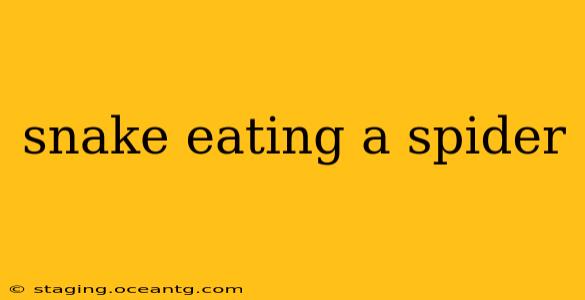Snakes consuming spiders is a fascinating example of predator-prey dynamics in the natural world. While not all snakes prey on spiders, many species, particularly smaller snakes, incorporate arachnids into their diets. This interaction highlights the intricate balance and diversity within ecosystems. This post will explore the specifics of this intriguing natural event, answering common questions and delving into the ecological implications.
What Kind of Snakes Eat Spiders?
Many smaller snake species include spiders as part of their diet. This isn't usually a primary food source, but rather a supplemental meal, especially for younger snakes. Specific species that have been observed consuming spiders include, but aren't limited to, various garter snakes, some rat snakes, and certain species of slender snakes. The size of the spider in relation to the snake is a crucial factor; larger snakes generally target larger prey.
How Do Snakes Catch Spiders?
The hunting techniques snakes employ to capture spiders are varied and depend on the snake species and the type of spider. Some snakes might ambush spiders in their webs, quickly striking and consuming the unsuspecting arachnid. Others might actively search for spiders under rocks, in leaf litter, or in crevices. The speed and precision of the strike are essential, given the spider's potential to defend itself with venom or biting.
Do All Snakes Eat Spiders?
No, not all snakes eat spiders. A snake's diet is largely determined by its size, the availability of prey, and its specific adaptations. Larger snakes, such as pythons and boas, generally focus on larger prey like rodents, birds, or even other reptiles. Smaller snakes, however, are more likely to supplement their diet with insects and other invertebrates, including spiders. The dietary preferences vary greatly depending on the snake species.
Are Spiders Poisonous to Snakes?
Some spider species are indeed venomous, and their venom could potentially harm or even kill smaller snakes. However, many snakes have developed resistance or immunity to certain spider venoms. The outcome of a snake-spider encounter depends largely on the species of both the snake and the spider, and the size of the snake relative to the spider. Larger spiders pose a greater threat than smaller ones.
What Happens After a Snake Eats a Spider?
After consuming a spider, the snake's digestive system begins the process of breaking down the spider's body. The digestive enzymes break down the spider's tissues, extracting the nutrients. The undigestible parts, like the exoskeleton, are later expelled as waste. The time it takes to digest a spider varies depending on the size of both the spider and the snake, as well as environmental factors like temperature.
Are There Any Videos of Snakes Eating Spiders?
Yes! Numerous videos showcasing snakes eating spiders can be found on various online platforms. Searching for "snake eating spider" on YouTube, for example, will yield a wide array of results. Keep in mind that viewing these videos should be approached with respect for the animals involved and an understanding of their natural behaviors.
This exploration of snakes eating spiders provides just a glimpse into the complex interactions within ecosystems. Further research into specific snake and spider species would reveal even more fascinating details about these predator-prey relationships. The diversity of life, even within seemingly small interactions, is a testament to the wonders of the natural world.
